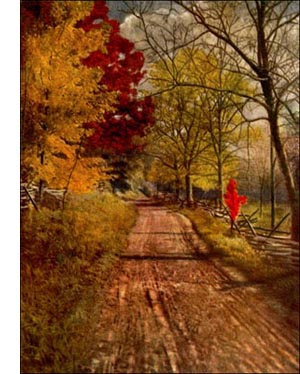Buckeyes
 FAMILY HIPPOCASTANACEAE
FAMILY HIPPOCASTANACEAEGenus AESCULUS, Linn.
Trees with ill-smelling bark and soft wood. Leaves palmately compound, opposite, large. Flowers perfect, large, showy, in panicles. Fruit a nut; one or two of them in a 3-celled, 3-parted husk.
There are but few of our native tree families whose leaves are set opposite upon the twigs. The horse chestnut family is one of them. This is an important family trait, wherever it occurs; it is shared by the ashes, maples, dogwoods, catalpas, viburnums and elders.
Of these six the first and last have compound leaves. So a tree with opposite and compound leaves, if a native, is almost sure to be an ash, an eider or a buckeye. Ash and elder leaflets are always distributed in pairs along the sides of the main leaf stalk.
The buckeyes all hunch their leaflets at the end of the leaf stem. They are palmately compound, while those of the ash are pinnately compound. This simple and easy mode of identifying opposite-leaved trees is set forth more graphically in the Key to the Families.
Buckeyes are distinguished by large winter buds, showy flowers in pyramidal racemes, large handsome foliage, and large nuts in 3-valved husks.
Every continent of the Northern Hemisphere has its buckeyes. There are eleven species in all. Of these America has four in her own right; the horse chestnut of Asia Minor is much oftener planted in this country than the native kinds. Indeed this species is the most cosmopolitan of trees, being found in the parks of cities in all regions where the climate permits it to thrive. It is a hardy immigrant, springing up spontaneously in some sections of our Eastern States.
The name "buckeye" is traceable to the brown nut marked with white, which suggested to somebody's fancy the eye of a deer. "Horse chestnut" employs the word horse to indicate that the fruit, which resembles the familiar edible chestnut, is unfit for human food. One nibble will prove to anyone its rank quality. These nuts lie untouched by squirrels through the most trying of winters. A strange circumstance is that the name Aesculus was the classical name of an oak tree, and it is very similar in form to the Latin word which means edible. Acorns formed an important part of the diet of primitive peoples, but it is hard to imagine an edible horse chestnut. Bitter, astringent bark and seeds are characteristic of the whole family.
In Mexico and Central America grow two species of the genus Billia, trees with three leaflets instead of five or seven. Othertwise, the trees are like the buckeyes, and are included in the family. The maples with their opposite leaves are near relatives of the buckeyes.
California Buckeye Tree
Horse Chestnut Tree
Ironwood or Inkwood Tree
Ohio Buckeye or Fetid Buckeye Tree
Soapberry Tree
Spanish Buckeye Tree
White Ironwood Tree
Wild China Tree
Yellow Buckeye or Sweet Buckeye Tree